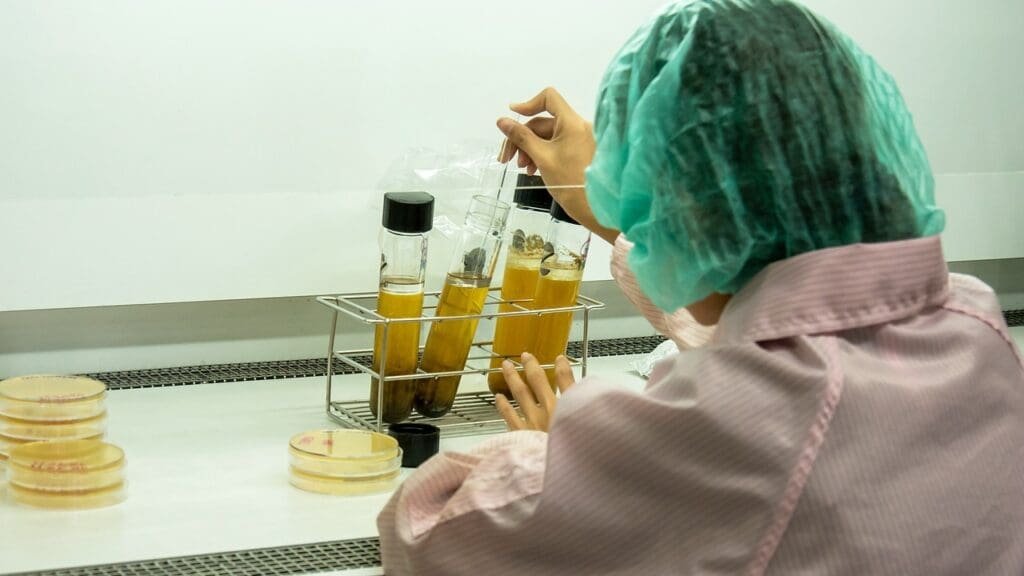Last Updated on November 27, 2025 by Bilal Hasdemir

We are dedicated to giving the best care to cancer patients. A big part of this is knowing how alkylating chemotherapeutic agents help in treatment.
These agents are a special type of anticancer drug. They add alkyl groups to DNA, causing damage. This damage stops cells from dividing, which is why they’re so effective in cancer treatment.
At places like Liv Hospital, we use these drugs to give new, focused care to patients. It’s important to understand how alkylating chemotherapy works. This knowledge helps us improve cancer treatment.
Key Takeaways
- Alkylating agents are a key class of anticancer drugs.
- They damage DNA to stop cancer cells from dividing.
- These agents are used in many cancer treatment plans.
- Knowing how they work is essential for good cancer care.
- Using alkylating chemotherapy in new ways helps patients more.
The Fundamental Role of Alkylating Agents in Cancer Treatment
Alkylating agents have a long history, starting in warfare. Now, they are key in fighting cancer. They work by messing with the DNA of cancer cells, stopping them from growing. These agents are vital in chemotherapy, helping treat many types of cancer.
Definition and Historical Development
Alkylating agents are drugs that add an alkyl group to cancer cells’ DNA. This damages the DNA and stops the cells from making copies. This is how they help treat cancer.
From Warfare to Medicine: The Origin Story
Alkylating agents started in warfare, in World War I and II. They were used as chemical weapons. But, seeing how they affected soldiers showed they could target fast-growing cells, like cancer cells.
This discovery led to their use in fighting cancer. It’s a great example of how science can change from one field to another.
Today, alkylating agents are a mainstay in cancer treatment. They help with leukemia, lymphoma, and some solid tumors. Their journey from warfare to medicine shows how science can adapt and help us.
| Alkylating Agent | Primary Use | Mechanism |
|---|---|---|
| Cyclophosphamide | Various cancers, including lymphoma and leukemia | DNA alkylation |
| Chlorambucil | Chronic lymphocytic leukemia | DNA cross-linking |
| Melphalan | Multiple myeloma and ovarian cancer | DNA alkylation and cross-linking |
Fact 1: Mechanism of Action – DNA Damage and Cell Death
Alkylating agents add alkyl groups to DNA, causing damage. This damage starts cell death pathways. Their role in cancer treatment is key, targeting fast-growing cells.
The DNA Alkylation Process Explained
DNA alkylation happens when alkylating agents add alkyl groups to DNA. This creates cross-links between DNA strands and strand breakage. It severely damages the DNA.
This damage stops cancer cells from dividing and growing. It’s vital for alkylating agents to fight cancer.
Transfer of Alkyl Groups
The transfer of alkyl groups to DNA is a key step. It involves attaching an alkyl group to DNA, usually at the N7 position of guanine. This disrupts DNA’s normal function.
Cells face stress from DNA alkylation, leading to cell death. This is more common in fast-growing cancer cells. So, alkylating agents are good at targeting tumors.
Fact 2: Cell Cycle Phase-Nonspecific Properties
Alkylating agents have a big plus: they can hit cancer cells at any time. This makes them great for fighting many types of cancer. Let’s see how this helps in cancer treatment.
Targeting Cells at Any Stage of Division
Alkylating agents are cell cycle phase-nonspecific. They can harm cells at any part of the cell cycle. Unlike some drugs, they work on cells in any division stage.
This means they can kill cancer cells whether they’re busy growing or just resting. This is key because cancer cells can be in different stages. Traditional treatments might miss some cells, but alkylating agents get them all.
The non-specificity of alkylating agents is a big win in cancer treatment. It lets doctors tackle tumors more fully. This is super helpful for slow-growing tumors or those with many resting cells.
Fact 3: Classifications of Alkylating Chemotherapeutic Agents
Alkylating chemotherapeutic agents are divided into groups based on their structure and how they work. These groups help us understand their uses and effects in fighting cancer.
Nitrogen Mustards
Nitrogen mustards are among the first and most recognized types of alkylating agents. They attach to DNA, stopping cancer cells from growing. Cyclophosphamide and chlorambucil are examples used in chemotherapy. They help treat cancers like lymphomas and leukemias.
For more on cancer drugs, check out LivHospital’s guide on oncology drugs.
Nitrosoureas
Nitrosoureas are another key group of alkylating agents. They can get into the brain, making them great for brain tumors. Carmustine (BCNU) and lomustine (CCNU) are examples used in treatment. They cause DNA damage and death in cancer cells.
By grouping alkylating agents, like nitrogen mustards and nitrosoureas, we gain insight into their actions and uses. This knowledge is vital for doctors to choose the right chemotherapy plans.
Fact 4: Common Examples and Their Specific Applications
Cyclophosphamide and ifosfamide are key drugs in cancer treatment. They are effective and widely used. These medicines help manage many types of cancer and have been studied a lot.
Cyclophosphamide and Ifosfamide
Cyclophosphamide and ifosfamide are important in fighting cancer. They are used for lymphomas, leukemias, and solid tumors. These drugs are essential in oncology.
Mechanism and Metabolism
These drugs work by creating DNA cross-links, causing cell death. Cyclophosphamide turns into 4-hydroxycyclophosphamide in the liver. This active form kills cancer cells.
Ifosfamide also gets activated in the liver, becoming 4-hydroxyifosfamide. How these drugs are broken down affects their effectiveness and side effects.
Some important points about cyclophosphamide and ifosfamide are:
- They are effective against many cancers
- They are part of many chemotherapy plans
- They need careful dosing and monitoring because of side effects
Knowing how these drugs work and get broken down is key. It helps make cancer treatment better.
Fact 5: Metabolism and Activation Requirements
To understand how alkylating agents work, we need to know about their metabolism and activation. Many of these agents start as prodrugs. These are inactive compounds that need to be changed to work.
Prodrug Conversion Processes
The change from prodrugs to active forms is key for their effectiveness. This change happens through different metabolic pathways. The liver is a major player in this process.
Liver Metabolism Pathways
The liver breaks down alkylating agents through various enzymatic steps. For example, Cytochrome P450 enzymes are important in the oxidation of these agents. This helps them become active or get broken down. Knowing these pathways is vital for understanding how well these agents work and their possible side effects.
For effective cancer treatment with alkylating agents, it’s important to understand their metabolic activation. This knowledge helps doctors create better treatment plans and reduce side effects.
Fact 6: Side Effects and Toxicity Profiles
Alkylating agents in chemotherapy can cause side effects and toxicity. Clinicians must manage these carefully. These agents fight cancer cells but can harm normal cells too.
Common Adverse Reactions
Alkylating agents lead to side effects like bone marrow suppression, stomach problems, and hair loss. Bone marrow suppression is serious. It can cause low blood cell counts, making infections and bleeding more likely.
Bone Marrow Suppression
Bone marrow suppression is a big concern with alkylating agents. It means fewer blood cells are made. This needs close watching and might mean changing doses or using growth factors or blood transfusions.
Knowing the toxicity profiles of alkylating agents is key to using them well in cancer treatment. By understanding side effects, doctors can help patients better. This improves how well patients do and their quality of life.
Handling side effects from alkylating agents takes teamwork. It includes teaching patients, checking on them often, and acting fast when needed. This way, doctors can give patients the best care while using these agents.
Fact 7: Resistance Mechanisms to Alkylator Therapy
Resistance to alkylating agents is a big problem in cancer treatment. It comes from many cellular adaptations. Knowing how resistance forms is key to better treatments.
Alkylating agents damage cancer cells’ DNA, stopping them from dividing. But, cancer cells can resist these agents in several ways. One main way is by improving DNA repair. Cancer cells boost their DNA repair, fixing damage from alkylating agents better.
Cellular Adaptations and DNA Repair
Cellular changes are key in fighting alkylating agents. Cells can change their environment to make drugs less effective. For example, they can improve detox processes, reducing drug levels inside the cell.
Also, changes in how cells die can help them resist drugs. Cancer cells can avoid dying, even with a lot of DNA damage. This shows we need treatments that hit different targets.
Experts say, “Fighting resistance to alkylating agents is complex, involving many cell actions.” Knowing these actions is vital for finding ways to beat resistance and better treatments.
“The rise of resistance to alkylating agents is a big hurdle in cancer treatment, pushing for new research into better therapies.”
By diving deeper into how cells resist, we can make treatments more effective. This will help improve results for patients.
Clinical Applications Across Different Cancer Types
Alkylating agents are used in many cancer types, helping a lot with blood cancers. They work on different cancers, like leukemias and lymphomas. They’re great because they can hit cells that are growing fast.
Treatment Protocols for Hematologic Malignancies
Alkylating agents are key in treating blood cancers. They’re mixed with other drugs to make treatments better. For example, in multiple myeloma, drugs like melphalan prepare patients for stem cell transplants.
Leukemias and Lymphomas
For leukemias and lymphomas, drugs like cyclophosphamide and bendamustine are used. They help patients get better and live longer. Cyclophosphamide is used in treatments for non-Hodgkin lymphoma and chronic lymphocytic leukemia.
We keep using alkylating agents because they work well and we know they’re safe. Researchers are always looking for ways to make them even better and safer.
Advances in Alkylating Antineoplastic Agent Development
Recently, there have been big steps forward in making alkylating antineoplastic agents. We’re moving towards treatments that are more precise and less harsh. This change is helping patients live better lives and fight cancer more effectively.
At the heart of this progress are new compounds and ways to deliver them. Scientists are working hard to make these agents work better and cause fewer side effects. They aim to create drugs that only hit cancer cells, leaving healthy cells alone.
Novel Compounds and Formulations
New drugs are being made to fix the problems of old ones. For example, novel nitrogen mustards and nitrosoureas are being crafted to work better. Also, new ways to get these drugs to tumors are being developed.
How these drugs are packaged is also getting a boost. Things like nanoparticles are being used to make the drugs more effective. These advances could lead to better results and fewer side effects for patients.
Conclusion: The Future of Alkylating Agents in Cancer Treatment
Alkylating agents have been key in cancer treatment for many years. They damage DNA, stopping cells from growing and leading to cell death. The nitrogen mustard family, aziridines, nitrosoureas, and platinum-based drugs are among the most promising.
But, these agents have their downsides, like side effects and resistance. Researchers are working hard to make them safer and more effective. They’re looking into new compounds and ways to deliver these drugs better. This could lead to big improvements in alkylating agent development and cancer treatment.
Looking ahead, alkylating agents will keep being a big part of cancer treatment. We need to keep funding research to make the most of them. With new discoveries, we hope to see treatments that are more precise and effective. This will help make chemotherapy better for patients.
FAQ
What are alkylating chemotherapeutic agents?
Alkylating chemotherapeutic agents are drugs used to fight cancer. They attach an alkyl group to the DNA of cancer cells. This damages their DNA and stops them from reproducing.
How do alkylating agents work in cancer treatment?
These agents work by damaging DNA in cancer cells. They add alkyl groups to DNA, causing harm. This harm leads to the death of cancer cells.
What is the historical background of alkylating agents?
Alkylating agents have been used in cancer treatment for a long time. They were first used to treat certain cancers. Now, they are a key part of chemotherapy.
Are alkylating agents cell cycle phase-specific?
No, alkylating agents are not specific to any cell cycle phase. They can target and kill cancer cells at any stage. This makes them useful for treating many cancers.
What are some examples of alkylating agents?
Examples include cyclophosphamide and ifosfamide. These drugs are used to treat various cancers, like leukemias and lymphomas.
How are alkylating agents metabolized?
These agents are given as prodrugs that need to be activated. The liver is key in this process, turning them into their active forms.
What are the common side effects of alkylating agents?
Side effects include bone marrow suppression. There are ways to manage these effects and reduce their impact.
How do cancer cells develop resistance to alkylating agents?
Cancer cells can become resistant through several ways. This includes changes in cells and better DNA repair.
What are the different classifications of alkylating chemotherapeutic agents?
Alkylating agents are divided into types like nitrogen mustards and nitrosoureas. Each type has its own use and characteristics.
What is the role of alkylating agents in treating hematologic malignancies?
Alkylating agents are key in treating blood cancers like leukemias and lymphomas. They are often used in combination with other drugs.
Are there any advances in the development of alkylating antineoplastic agents?
Yes, new research is focused on improving these agents. The goal is to make them more effective and less harmful.
What is the future of alkylating agents in cancer treatment?
Future research will likely lead to even better treatments. This could include new and more effective alkylating agents.
References
- National Center for Biotechnology Information (NCBI) / Books: https://www.ncbi.nlm.nih.gov/books/NBK547849/
- Sketchy: https://www.sketchy.com/medical-lessons/alkylating-agents
- National Center for Biotechnology Information (NCBI) / Books: https://www.ncbi.nlm.nih.gov/books/NBK12772/
- Osmosis: https://www.osmosis.org/learn/Alkylating_agents:_Nursing_Pharmacology








